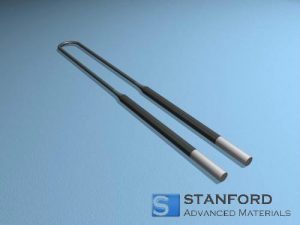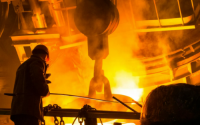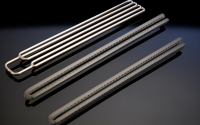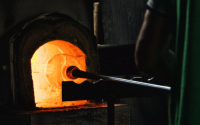Comparative Analysis of Heating Elements: Molybdenum Disilicide vs. Traditional Materials
Introduction
Heating elements are essential components in a variety of industrial and laboratory applications, providing the necessary thermal energy for processes such as heat treatment, material testing, and production. Among the many materials used for heating elements, Molybdenum Disilicide (MoSi2) stands out due to its exceptional properties. This analysis compares MoSi2 heating elements with traditional materials such as Kanthal and Silicon Carbide (SiC), highlighting their respective advantages and limitations.

Properties of Heating Elements
1. Molybdenum Disilicide (MoSi2)
– Melting Point: Approximately 2,030°C (3,686°F)
– Oxidation Resistance: Excellent due to the formation of a protective silica (SiO2) layer
– Electrical Conductivity: High for a ceramic material
– Mechanical Strength: Maintains strength at elevated temperatures
– Service Life: Long due to resistance to oxidation and thermal cycling
Related reading: Molybdenum Disilicide Heating Elements: Revolutionizing High-Temperature Applications
2. Kanthal (FeCrAl Alloy)
– Melting Point: Approximately 1,425°C (2,597°F)
– Oxidation Resistance: Good, with the formation of a protective aluminum oxide (Al2O3) layer
– Electrical Conductivity: Moderate
– Mechanical Strength: Good at moderate temperatures, but degrades at very high temperatures
– Service Life: Long, but shorter than MoSi2 at high temperatures
3. Silicon Carbide (SiC)
– Melting Point: Sublimes at about 2,700°C (4,892°F)
– Oxidation Resistance: Good, but forms a protective layer only at temperatures above 1,000°C (1,832°F)
– Electrical Conductivity: Good
– Mechanical Strength: High but brittle, prone to thermal shock
– Service Life: Long in certain conditions, but susceptible to degradation in fluctuating temperatures
Related reading: Heating Elements: Molybdenum Disilicide vs Silicon Carbide
Performance Comparison
1. Operating Temperature Range
– MoSi2: Suitable for temperatures up to 1,800°C (3,272°F) and beyond, making it ideal for high-temperature applications.
– Kanthal: Effective up to 1,400°C (2,552°F), suitable for a wide range of industrial applications but limited in very high-temperature environments.
– SiC: Can operate at temperatures up to 1,600°C (2,912°F), but less stable than MoSi2 at these extremes.
2. Oxidation Resistance
– MoSi2: Excellent, with a self-healing SiO2 layer that protects against oxidation even at very high temperatures.
– Kanthal: Good, with a protective Al2O3 layer, but less effective at the highest temperatures.
– SiC: Good, with an oxidation-resistant layer forming at high temperatures, but less effective at lower operating temperatures.
3. Mechanical Properties and Durability
– MoSi2: High mechanical strength at elevated temperatures, but can be brittle.
– Kanthal: Good mechanical properties at moderate temperatures but degrades at higher temperatures.
– SiC: Very high strength but prone to thermal shock and brittleness.
4. Energy Efficiency and Cost
– MoSi2: High efficiency due to high operating temperatures and longevity, but higher initial cost.
– Kanthal: Moderate efficiency and cost-effective for lower temperature applications.
– SiC: Efficient at high temperatures, with moderate initial costs but potential higher maintenance costs due to brittleness.
Applications
MoSi2 heating elements are ideal for high-temperature industrial furnaces, glass manufacturing, and semiconductor production. They are particularly suitable for applications that require sustained high temperatures and long service life due to their excellent thermal stability and oxidation resistance.
Kanthal heating elements are commonly used in lower temperature industrial applications, household appliances, and laboratory furnaces. They are well-suited for environments where extreme temperatures are not required, offering good performance and durability at moderate temperatures.
SiC heating elements are used in high-temperature furnaces, kiln applications, and heating elements for the ceramics industry. They are effective in environments with stable high temperatures, but they are less suitable for conditions with fluctuating temperatures due to their susceptibility to thermal shock and brittleness.
Conclusion
Molybdenum Disilicide (MoSi2) heating elements offer superior performance in high-temperature environments compared to traditional materials like Kanthal and Silicon Carbide (SiC). Their exceptional oxidation resistance, high melting point, and mechanical strength make them ideal for demanding industrial applications.
However, the choice of heating element material should consider specific application requirements, including operating temperature range, mechanical properties, and cost-effectiveness. Understanding these factors can guide the selection of the most suitable heating element material for a given application, ensuring optimal performance and longevity. For more information, please check Stanford Advanced Materials (SAM).
| Parameter | MoSi2 | Kanthal | SiC |
| Operating Temperature Range | Up to 1,800C (3,272F) and beyond | Up to 1,400C (2,552F) | Up to 1,600C (2,912F) |
| Oxidation Resistance | Excellent, with a self-healing SiO2 layer | Good, with a protective Al2O3 layer | Good, with an oxidation-resistant layer forming at high temperatures |
| Mechanical Properties and Durability | High mechanical strength at elevated temperatures, but can be brittle | Good mechanical properties at moderate temperatures but degrades at higher temperatures | Very high strength but prone to thermal shock and brittleness |
| Energy Efficiency and Cost | High efficiency due to high operating temperatures and longevity, but higher initial cost | Moderate efficiency and cost-effective for lower temperature applications | Efficient at high temperatures, with moderate initial costs but potential higher maintenance costs |



